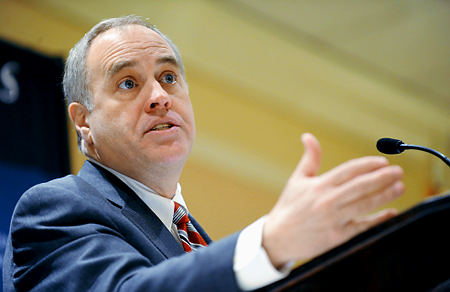

The Center for Research, Regional Education and Outreach (CRREO) partnered with the Hudson Valley Pattern for Progress to present the 2011 conference on local government called “The Tax Cap Challenge” on Oct. 3.
State officials, members of the school district and other members of local government attended this conference to discuss how they’re going to manage the 2 percent tax cap that was passed in June and placed on local governments to restrict the degree to which they can raise the increase of property taxes.
“[This conference] is less about complaining about the tax cap or claiming that it’s a bad idea,” said Gerald Benjamin, director of CRREO. “[It’s] more about coming to terms with it and figuring out how to operate with it.”
New York is a state burdened by property taxes, the presenters said. They see the tax cap as a way of constraining the burden on tax payers, said Benjamin. Therefore the local governments in New York, cities, towns, villages and school districts have to limit their tax levy or the increase on their tax levy.
This conference provided an opportunity for people to interact and understand ideas of how to function with restrictions placed on New York and local governments.
The conference agenda included a plenary session to discuss the tax cap itself and three panel discussions or breakout sessions on police, schools and assessors.
The two keynote speakers at this conference were Tom Suozzi, former county executive of Nassau County, and State Comptroller Thomas DiNapoli.
During his speech, Suozzi explained the genesis of the property tax cap and he attempted to connect the dots between the “dysfunction and the problems of Albany” to the problems local governments face.
“Local taxes in New York are 78 percent above the national average,” said Suozzi.
According to Suozzi, one of the reasons the state’s property taxes are so high is because of state mandated taxes.
He said the government is spending an enormous amount of money on a system that doesn’t provide good service. A few examples being school districts and Medicaid.
“We spend more per student than any state in the United States of America,” said Suozzi. “But our results aren’t the highest in the nation, nowhere near the highest in the nation.”
Suozzi also said that New York State spent two-and-a-half times more on Medicaid than the rest of the nation.
“Here we are spending the money, but we’re not getting the results for the money we’re spending,” said Suozzi.
According to Suozzi these high costs are related to the mandates New York has, and these mandates are related to “some of the bureaucracy we get when we spend more time on mandates then we do on actually getting results.”
Suozzi suggests that instead of implementing property tax caps, the state mandate should be addressed.
Benjamin said the Tax Cap will be challenging for schools because they’re “hard pressed to operate within the cap.” It will also be challenging for local governments because they’ll have to control their costs by being more efficient and doing fewer things.
“The issue comes down to how many people you employ, what you pay them, and what benefits you give them,” said Benjamin.
If the costs of state mandated programs remain driven by state requirements, and the counties can’t get more money then the counties will have to reduce their costs in the areas they have discretion such as highways. This means that if they’ll have to make budget cuts to areas where they have most discretions, meaning that local governments may be forced to lay off police officers, fire fighters and high way workers if this situation occurs.
A local law can be enacted to override the tax levy limit, but it requires a 60 percent vote of the total power of the governing body to pass, according to www.ny.gov.
“I think it’s a way of driving localities to working together to reduce their costs,” said Benjamin. “But I’m a little concerned about whether it could be affective over a long period of time.”
